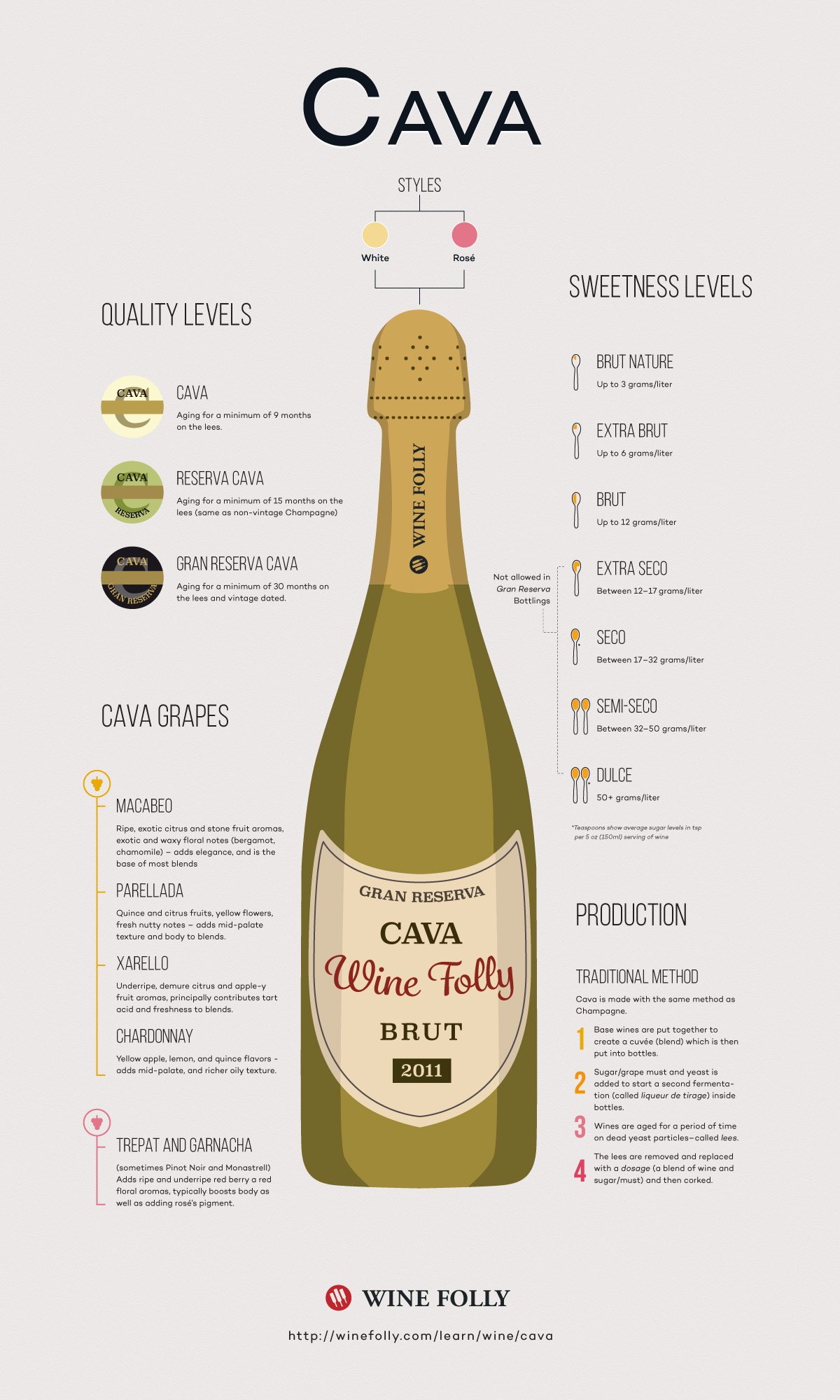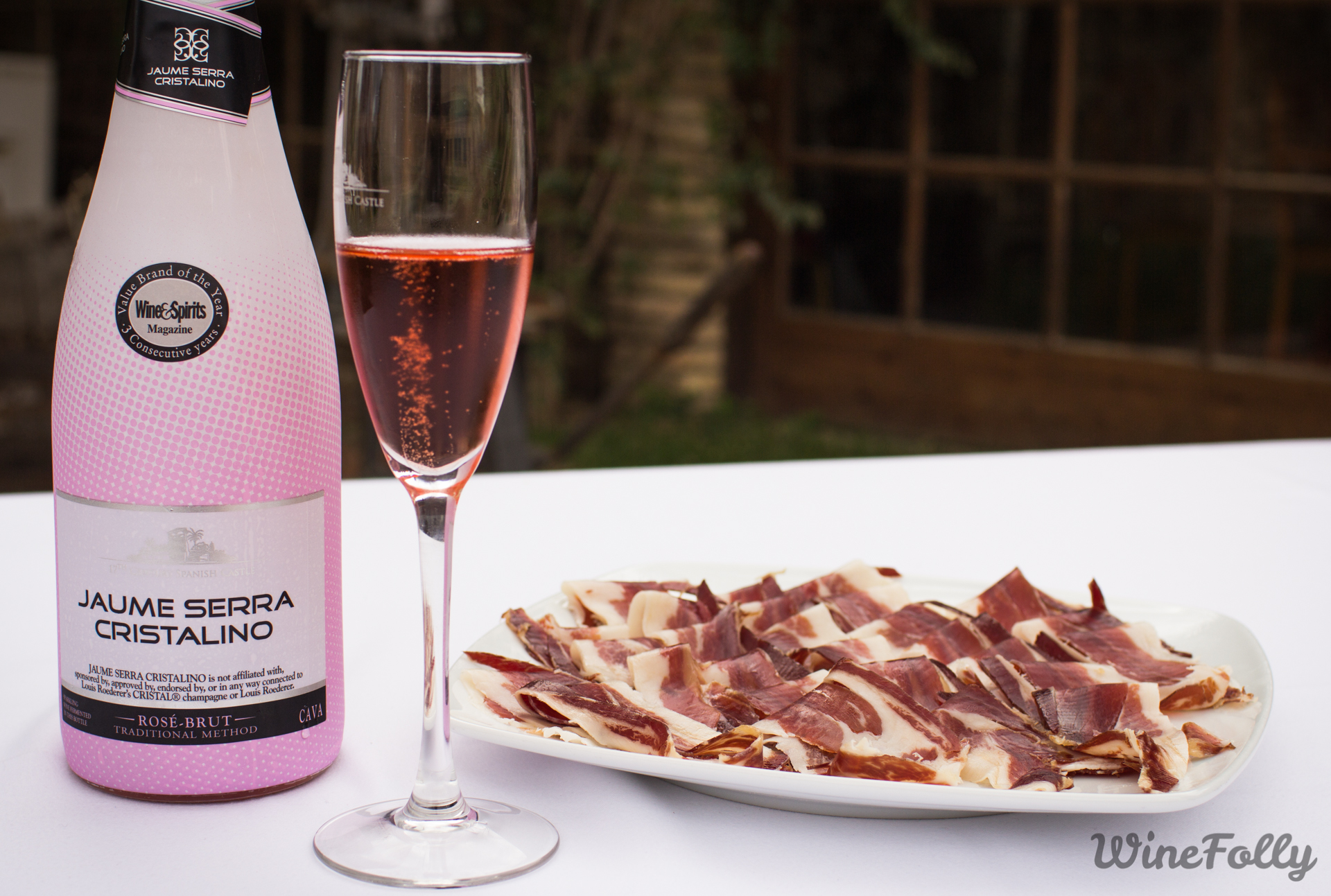If you drink sub-$20 sparkling wine on New Year’s Eve, chances are it’s either Prosecco or Cava. So you’re probably wondering…
What Is Cava?
Cava is like the “Champagne of Spain.” It’s produced the same way as Champagne but with different grapes. If you’re looking for better value on phenomenal wines, this is a place to start hunting.
Let’s find out what Cava is and what makes it unique by understanding the production method, different styles, labeling conventions, and grape varieties.
What To Expect Tasting Cava
What sets Cava apart from other renowned sparkling wines are its Spanish grapes. Overall, Cava tastes lean, citrusy, and savory. Each grape used in Cava adds a unique quality to the blend.
- Macabeo (white): (aka Macabeu or Viura in Rioja) is the main grape in Cava and accounts for the most vineyard plantings of any other grape across the D.O. (Designation of Origin). It has faint floral aromatics, a lemony flavor, and a slightly bitter finish that tastes similar to green almonds.
- Xarel·lo (white): Xarel·lo (sounds like ‘cheryl-ooh’), on the other hand, is much more aromatic with rich floral aromas and pear/melon-like notes. It adds complexity and a zingy acidity that boosts the wine’s aging potential.
- Parellada (white): Parellada brings delicate citrusy and white flower notes to the blend, while its lower acidity adds smoothness and balance.

In addition to the main Spanish grapes (or, in some cases, instead of), Cava producers can include several other grape varieties.
- Chardonnay (white): Versatility is Chardonnay’s biggest attribute, as it can adapt to many soil types and conditions. It also adds freshness and acidity, especially when harvested early.
- Subirat Parent (white): Subirat Parent (aka Malvasia) lends structure and aromatics. It’s most common in Dulce and Semi Seco Cava.
What about Cava Rosé
Though not as common (rosé accounts for only 8% of Cava’s production), Cava rosé requires red grapes for the color. The allowable red grapes include:
- Garnacha (aka Grenache)
- Monastrell (aka Mourvèdre)
- Trepat
- Pinot Noir


Cava Sweetness Levels
Is Cava Sweet? No, not usually.
Brut Cava is most likely what you see on wine store shelves, as is the case with Champagne. However, Extra Brut and Brut Nature, both drier than Brut, are growing in popularity because of being lower in calories.
Aside from sweetness, Cava has a wide range of styles. Young Cava features citrus and orchard fruit aromas such as quince, yellow apple, lime, and Meyer lemon.
Vintage and Cava aged on the lees have incredible body as well as nutty and toasty qualities, with baked notes of apple and almond. It all depends on how long producers choose to age their Cava.

The Secret To Great Cava Lies in Winemaking
The bready quality of Cava that has everyone swooning comes from the winemaking method, which is the same as Champagne. The unique production process involves trapping dissolved carbon dioxide inside the bottle to make bubbles.
While the bubbles form in a few weeks, the real magic happens during autolysis (“atahl-leh·suhs”), a process where enzymes from dead yeast cells (called “lees”) enrich the wine. This adds savory flavors like fresh bread dough, white chocolate, and marzipan. The longer the autolysis, the more these flavors develop.
Most Cava undergoes at least nine months of lees aging. When Cava ages longer than this, they have the potential to deliver savory notes like brioche, almond skin, toasted hazelnut, or smoke.

Cava Quality Categories
Most Cava sold in the market are aged for a minimum of 9 months which is fresh and fruity, but won’t have that toasty quality. You get toastiness from Cava’s higher quality tiers called Cava de Guarda Superior.
Within Cava’s two main categories (Cava de Guarda and Cava de Guarda Superior), four quality sub-categories exist.
Cava (Cava de Guarda):
- Minimum aging requirement: 9 months
- Available in all levels of sweetness
- Maximum yields: 12,000 kg/ha (5.35 tons/acre)
Cava Reserva (Cava de Guarda Superior)
- Minimum aging requirement: 18 months (elevated from 15 months in 2020)
- Available in all levels of sweetness
- Maximum yields: 10,000 kg/ha (4.46 tons/acre)
Cava Gran Reserva (Cava de Guarda Superior)
- Minimum aging requirement: 30 months
- Available in Brut Nature, Extra Brut, or Brut only
- Maximum yields: 10,000 kg/ha (4.46 tons/acre)
Cava de Paraje Calificado (Cava de Guarda Superior)
- Minimum aging requirement: 36 months
- Available in Brut Nature, Extra Brut, or Brut only
- Maximum yields: 8,000 kg/ha (3.57 tons/acre)
In addition to the requirements above, all Cava de Garda Superior Wines must also:
- Be organic (requirement beginning with vintage 2025)
- Come from a specific quality-designated site or vineyard
- Have a minimum vine age of 10 years
- Have a vintage designation
- Be traceable from harvest to bottling to market

Where Cava Comes From
You’ll find 95,000 acres (38,273 ha) dedicated to Cava sparkling wines in Spain. Surprisingly, around 95% of Cava comes from just one area in Comtats de Barcelona in Penedés, Spain. It’s here that we find the “Capital of Cava” around the municipality of Sant Sadurní d’Anoia where the first sparkling Cava came out in 1872.
Technically speaking, Cava has four main wine-growing zones, including subzones.
Comtats de Barcelona
Valle del Ebro
Viñedos de Almendralejo
Requena

A Note on Affordability
Have you ever wondered why Cava, with its similarities to Champagne, is so much more affordable? The answer lies in a single word: technology.
For example, at Jaume Serra, near Barcelona, mechanization plays a crucial role in producing, storing, and bottling Cava efficiently and cost-effectively.
The facility also features automated forklifts operating in perfect formation, meticulously collecting, riddling, and stacking millions of bottles without human intervention. The warehouse is bustling with activity, yet no people are in sight. Despite this high level of automation, the resulting wines are remarkably delicious.
This kind of technology shows how mechanization and automation help make Cava both affordable and high-quality.

Does Cava Pair with Food?
Absolutely, it does! Cava is an amazing wine to have with Spanish favorites like tapas and paella, but also amazing with Mexican food, like fajitas, and get this, red bean chili.
The Last Word
Cava, especially on the higher end, continues to fly under the radar, and you can find many exceptional values at Spanish-focused wine stores.
Drinking fine bubbles every day is absolutely possible thanks to wines like Cava, Crémant, and Prosecco, drinking bubbles every day is absolutely possible. Remember, sparkling isn’t for occasions, it is the occasion!